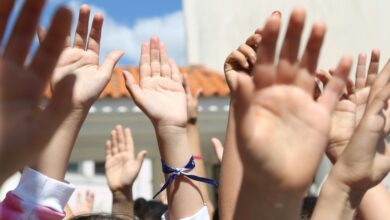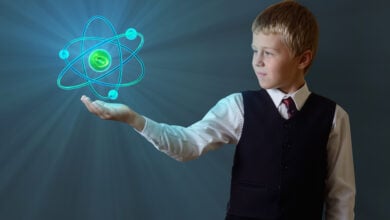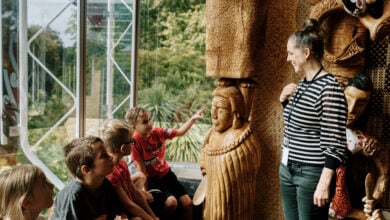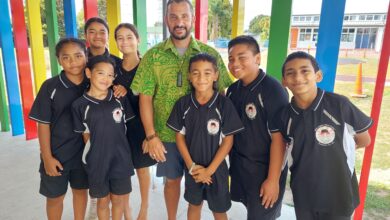Technology focus brings improved outlook for the deaf
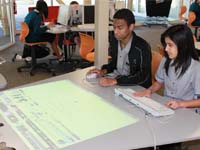
 Just a decade or two ago, deafness or serious hearing impairment usually meant a fairly bleak future for those affected. Often, it entailed a large degree of isolation from the wider community and a working lifetime of menial work at best.
Just a decade or two ago, deafness or serious hearing impairment usually meant a fairly bleak future for those affected. Often, it entailed a large degree of isolation from the wider community and a working lifetime of menial work at best.
But times have changed and very much for the better. New and improved technology, combined with better pedagogies now mean that achievement levels for deaf children can be as high as their hearing peers.
On one side, improved hearing aids, cochlear implants and classroom sound systems mean that many more children are able to access sound sufficiently well to learn in an orthodox way. Those who struggle to access sound can however take advantage of computers of various types, mobile phones, improved projectors and other electronic devices, which combined with new teaching methods, are bringing vastly improved results in scholastic achievement and career prospects.
Partnership breakthrough
A key to this success is a significant shift in focus in the schooling of deaf children. No longer are they destined for an education in isolation from other students – in fact they are now increasingly attending the same schools. These days, the emphasis is on treating them little, if any, differently from others and they are expected to achieve to the same level. This is having a spin-off in unexpected ways.
A major breakthrough has come in the way Auckland’s Kelston Deaf Education Centre (KDEC) operates. Instead of being a stand-alone entity, it has now become a network operation. While more than 100 students are enrolled in the school, those students are actually present daily on the campus of 10 partner schools across the greater Auckland area.
In addition, KDEC employs 58 itinerant teachers from Turangi to Kaitaia who visit and work with 350 individual deaf students in more than 250 mainstream schools. KDEC chief executive David Foster says an excellent example of how the partnership works is a school at Flat Bush, south Auckland, which opened in 2009.
“We have a partnership agreement at Mission Heights Junior College and a cohort of 17 of our year 7-10 students attend school there every day. Kelston also employs the staff members who work with those students. The daily curriculum delivery is a partnership between Mission Heights staff and its students, and Kelston staff and its students.”
Few boundaries
It is a partnership the staff at Mission Heights have taken on with enthusiasm, ensuring there are few boundaries between KDEC students and the rest. Said the principal, Joan Middemiss: “We try to move the Kelston children around the school as much as we can. Most are mainstreamed for many of their classes while some might have some classes, such as signing or English, separately.
“To all intents and purposes the KDEC children operate just like our Mission Heights students – they’re accepted as part of the whanau, they have the same uniform and they’ll go off to school camp just like all the others. They look happy and have high self esteem. They all share the same technology. We’re very digital here and it seems to be working incredibly well.”
Kelston Deaf Education Centre has now had partnership agreements for more than 20 years with some schools. Said David Foster: “One of our ongoing conversations with the Ministry of Education is how to raise achievement for our students. A key factor is subjecting them to really high expectations of performance. It’s also really important for our deaf students to appreciate that they’re part of a wider community.”
Wider horizons
He said one of the drawbacks of having the children at a deaf-only school is that their peer group is small, meaning restricted achievement expectations. Partnership agreements have given KDEC the opportunity to raise the bar. “Our kids now have an environment where their potential is not limited by the constraints of the cohort they are in. By working closely with the Ministry, we’ve been able to enter into those partnership agreements with brand new schools, like Mission Heights, so that our children have access to the most up-to-date learning environment possible. From our point of view, that’s win-win.”
Joan Middlemiss agrees: “It’s a two-way win really because we’ve found that our children have become totally accepting of the children with hearing disabilities. We have sign language courses and a lot of our children are learning to sign. One hearing girl’s whole friendship group is with KDEC students. She’s learned to sign to the point that they can have conversations together.” Many Mission Heights teachers also volunteered to learn signing.
Recent technology, such as interactive whiteboards, is used widely at the school, meaning teachers do not have to turn their backs on the class. “The deaf students love having it like a giant sized computer at their finger tips and they take to it like ducks to water,” said a KDEC teacher at the Mission Heights, Fiona Campbell “They prefer to do things live. If they don’t understand something, they go straight to Google.” Personal ID cards give all students access to their own settings on the numerous school computers, helping make KDEC students feel a part of the mainstream.
Technology focus
“We have a technology focus here for all our students,” said a Mission Heights teacher, Melanie Kindley. “We’ve have a lot of practice e-learning programmes that assist all students but have been really good for the KDEC ones in particular. We’re trialling other learning programmes as well.”
She said short-throw projectors have been another bonus. “They’re bright and don’t cast shadows over what we’re trying to teach.” The school imported the first ones at the end of 2008.
Foster: “Before that, data projectors had to be set up for each usage and the lighting dimmed. That’s anathema to KDEC students because it limits their ability to lip read, sign or see facial expressions. With short-throws, you can leave the lights on and still have all the benefits of projecting images the kids can interact with.”
Email is considered useful and cell phones are encouraged, as if other communication falters, a text or image will usually work. Said David Foster: “If you see deaf and hearing children seeking to make a friendship, one of the first things they’ll pull out is a cell phone.”
Multimedia learning on the school’s Moodle system benefits all the students while Sound-stream in every classroom has proved helpful to both students and teachers. Tables and even windows are often used as whiteboards. The furniture was especially chosen to suit the required learning methods.
Foster: “Since experiencing the benefits of technology at Mission Heights, we’ve retro-fitted it to our other partner schools. We’ve installed it at Kelston Boys High School, Kelston Girls and Kelston Primary, and assisted in the design of (nearby) Ormiston Senior College while it was being built.”
Academic success
Assessment of children’s hearing abilities from soon after birth is also boosting the chances of hearing-impaired people being able to have their learning needs established far sooner, meaning less likelihood of falling behind.
David Foster says the combination of new technology and customised teaching methods is paying off in a big way.
“We can show that deaf students enrolled at Kelston have got pretty much the same chances of achieving academic success as their hearing peers. We’ve tracked our NCEA results where appropriate in our partner schools, and our children are achieving at the same rate as the others. That’s down to the absolute energy of our teachers and their willingness to use new technology to improve the pedagogy.
“We have many examples of deaf children coming through the system in the last 20 years and achieving degrees of various kinds. They’ve then gone on to the career that they chose for themselves, rather than the vocation that society once imposed on them.”
New projectors aid learning
New technology has revolutionised learning methods in recent years. One recent example is with new ultra short throw projectors which are simpler to operate than earlier types and no longer require plunging a room into near darkness – a huge advantage for the hearing impaired in particular.
A prime example is Epson’s latest interactive projectors which were introduced to New Zealand earlier this year. They are the Epson EB-475Wi and EB-485Wi ultra short throw, which the company describes as affordable with the lowest cost Epson replacement lamp ever.
Epson’s business manager – Visual Imaging, Bruce Bealby, says the projectors offer simultaneous dual pen interactivity, access to all the resources on a laptop, network and the internet, and instant capture of added content and notations, without an interactive whiteboard.
“Installation is easy with no driver software to install on networked computers and no need to calibrate. These projectors auto calibrate, delivering highly accurate and reliable performance,” he said. “They have very fast response to pen movements and the most accurate pen detection. As you move the pen, notations are displayed virtually immediately, while writing on the image and clicking through programs is easy and intuitive for students of all ages.”
Both the EB-475Wi and EB-485Wi can be wall mounted (vertical projection) for larger group interaction or table mounted (horizontal projection), creating an intimate workspace for collaborative projects and research.
“The Easy Interactive Tools 2 software and Epson’s Instant Annotation mean there’s no need to wait for a PC to come online to hand write notes and diagrams or annotate an image from a document camera or CD/DVD player. Simply turn on the projector and get to work,” Bealby said.
Epson describes the EB-475Wi (2600 lumen) and EB-485Wi (3100 lumen) as brighter than previous models, more compact and with a shorter minimum throw distance. Also recently released are the ultra short throw EB-470, EB-475W, EB-480 and EB-485W. These have the same high performance specifications but are not interactive.
By Brent Leslie

